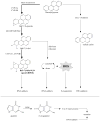Single cell gel electrophoresis (SCGE) and Pig-a mutation assay in vivo-tools for genotoxicity testing from a regulatory perspective: a study of benzo[a]pyrene in Ogg1(-/-) mice
- PMID: 25308545
- PMCID: PMC4196198
- DOI: 10.1016/j.mrgentox.2014.07.010
Single cell gel electrophoresis (SCGE) and Pig-a mutation assay in vivo-tools for genotoxicity testing from a regulatory perspective: a study of benzo[a]pyrene in Ogg1(-/-) mice
Abstract
The OECD has developed test guidelines (TG) to identify agents with genotoxic effects. The in vivo alkaline single cell gel electrophoresis (SCGE) assay is currently being prepared to become such a TG. The performance of a combined SCGE/Pig-a gene mutation study was evaluated with the prototypical genotoxicant benzo[a]pyrene (BaP) at an exposure level known to induce germ cell mutation. We aimed to better understand (i) the strengths and weaknesses of the two methods applied in blood and their potential to predict germ cell mutagenicity, and (ii) the involvement of reactive oxygen species (ROS) following in vivo BaP-exposure. To explore the involvement of ROS on BaP genotoxicity, we utilised a mouse model deficient in a DNA glycosylase. Specifically, C57BL/6 mice (Ogg1(+/+) and Ogg1(-/-)) were treated for three consecutive days with 50 mg BaP/kg/day. DNA damage in nucleated blood cells was measured four hours after the last treatment with the SCGE assay, with and without formamidopyrimidine DNA glycosylase (Fpg). Pig-a mutant phenotype blood erythrocytes were analysed two and four weeks after treatment. BaP-induced DNA lesions were not significantly increased in either version of the SCGE assay. The phenotypic mutation frequencies for immature and mature erythrocytes were significantly increased after two weeks. These effects were not affected by genotype, suggesting oxidative damage may have a minor role in BaP genotoxicity, at least in the acute exposure situation studied here. While both assays are promising tools for risk assessment, these results highlight the necessity of understanding the limitations regarding each assay's ability to detect chemicals' genotoxic potential.
Keywords: Alkaline single cell gel electrophoresis (SCGE); Benzo[a]pyrene (BaP); Genotoxicity; Hazard identification; Pig-a mutation assay; Risk assessment.
Copyright © 2014 Elsevier B.V. All rights reserved.
Figures




Similar articles
-
In vivo exposure to benzo(a)pyrene induces significant DNA damage in mouse oocytes and cumulus cells.Hum Reprod. 2014 Mar;29(3):548-54. doi: 10.1093/humrep/det439. Epub 2013 Dec 9. Hum Reprod. 2014. PMID: 24327538
-
Evaluation of in vivo genotoxicity induced by N-ethyl-N-nitrosourea, benzo[a]pyrene, and 4-nitroquinoline-1-oxide in the Pig-a and gpt assays.Environ Mol Mutagen. 2013 Dec;54(9):747-54. doi: 10.1002/em.21818. Epub 2013 Sep 18. Environ Mol Mutagen. 2013. PMID: 24105957
-
Genotoxic effects of two-generational selenium deficiency in mouse somatic and testicular cells.Mutagenesis. 2015 Mar;30(2):217-25. doi: 10.1093/mutage/geu059. Epub 2014 Oct 30. Mutagenesis. 2015. PMID: 25358475 Free PMC article.
-
Molecular Mechanisms of Action of Selected Substances Involved in the Reduction of Benzo[a]pyrene-Induced Oxidative Stress.Molecules. 2022 Feb 18;27(4):1379. doi: 10.3390/molecules27041379. Molecules. 2022. PMID: 35209168 Free PMC article. Review.
-
Genotoxicity of environmental agents assessed by the alkaline comet assay.Basic Clin Pharmacol Toxicol. 2005;96 Suppl 1:1-42. Basic Clin Pharmacol Toxicol. 2005. PMID: 15859009 Review.
Cited by
-
Genotoxic effects of high dose rate X-ray and low dose rate gamma radiation in ApcMin/+ mice.Environ Mol Mutagen. 2017 Oct;58(8):560-569. doi: 10.1002/em.22121. Epub 2017 Aug 30. Environ Mol Mutagen. 2017. PMID: 28856770 Free PMC article.
-
No cancer predisposition or increased spontaneous mutation frequencies in NEIL DNA glycosylases-deficient mice.Sci Rep. 2017 Jun 29;7(1):4384. doi: 10.1038/s41598-017-04472-4. Sci Rep. 2017. PMID: 28663564 Free PMC article.
-
Gamma radiation at a human relevant low dose rate is genotoxic in mice.Sci Rep. 2016 Sep 6;6:32977. doi: 10.1038/srep32977. Sci Rep. 2016. PMID: 27596356 Free PMC article.
-
Restoration of Cognitive Performance in Mice Carrying a Deficient Allele of 8-Oxoguanine DNA Glycosylase by X-ray Irradiation.Neurotox Res. 2018 May;33(4):824-836. doi: 10.1007/s12640-017-9833-7. Epub 2017 Nov 3. Neurotox Res. 2018. PMID: 29101721
References
-
- Kirkland D, Speit G. Evaluation of the ability of a battery of three in vitro genotoxicity tests to discriminate rodent carcinogens and non-carcinogens III. Appropriate follow-up testing in vivo. Mutat Res. 2008;654:114–132. - PubMed
-
- Singh NP, McCoy MT, Tice RR, Schneider EL. A simple technique for quantitation of low levels of DNA damage in individual cells. Exp Cell Res. 1988;175:184–191. - PubMed
-
- Boiteux S, Gajewski E, Laval J, Dizdaroglu M. Substrate specificity of the Escherichia coli Fpg protein (formamidopyrimidine-DNA glycosylase): excision of purine lesions in DNA produced by ionizing radiation or photosensitization. Biochemistry. 1992;31:106–110. - PubMed
-
- Dobrovolsky VN, Miura D, Heflich RH, Dertinger SD. The in vivo Pig-a gene mutation assay, a potential tool for regulatory safety assessment. Environmental and molecular mutagenesis. 2010;51:825–835. - PubMed
Publication types
MeSH terms
Substances
Grants and funding
LinkOut - more resources
Full Text Sources
Other Literature Sources
Research Materials
Miscellaneous

